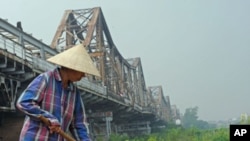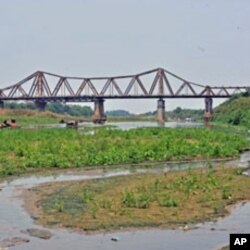A heated debate surrounds the future of a landmark prized as a symbol of stoicism during the Vietnam War. A plan to turn one of Hanoi’s most iconic landmarks, the Long Bien Bridge, into the world’s longest contemporary art museum has sparked controversy in Vietnam.
Just five minutes from the center of Hanoi, lines of motorbikes and bicycles cross the rickety tracks of Long Bien Bridge.
Built by the French in 1903 and repeatedly bombed by the United States during the Vietnam War, the railway bridge is integral to the city’s character. Its image as a patched-up war veteran is described throughout popular culture and is seen as a symbol of Vietnamese resolve in the face of war.
A plan to turn the bridge into the world’s longest contemporary art gallery, however, has triggered fierce debate between architects, journalists and Hanoi locals.
Bridge to hearts, minds
Nguyen Nga, a Vietnamese architect educated in France, first submitted the proposal in July to a meeting at the Vietnam Urban Planning Association.
Nga said the bridge is more than simply a means to cross the river - it is part of the hearts and minds of the people.
She said the bridge witnessed the withdrawal of the last French soldier from Vietnam, and was bombed 14 times by the Americans. Each time it was damaged, the Vietnamese people put it back together again.
Once the longest bridge in Indochina, she wants it to become the longest contemporary art museum in the world with the bridge’s 131 arches developed into galleries for craftsmen and artists.
Museum, park, restaurants and cafes
The museum would include a large exhibition hall with restored railroad cars transformed into restaurants and cafes.
The island in the middle of the river beneath the bridge, known as Bia Giua, would be be transformed into an art park.
Nga said the bridge is too precious to be used for cargo trains and should only be used for bicycles and pedestrians. The city plans to build more bridges across the river so they will not need the bridge for traffic.
When it was first opened in 1903, Long Bien could not have been more French. The bridge was originally named for Paul Doumer, then president of France and governor-general of French Indochina.
The designer also was another famous name in French history - Gustav Eiffel, the man who 14 years earlier designed the famous tower in Paris.
Storied landmark
When the French left Vietnam at the end of the first Indochina War in 1954, they took the name Paul Doumer with them and the grandiose landmark became Long Bien.
Today, the bridge is still a hive of activity. Hoang Kim Ngan, 42, is among dozens of women who sell snacks to passing traffic along the bridge.
Ngan said she has sold tea and fruit on the bridge for 10 years. She said it is a good place to set up a stall because there are fewer criminals, and sellers receive less hassle from the police.
Ngan said people come to the bridge in the evening to enjoy the fresh air and the view. Although Ngan is in favor of building a museum, she said she would rather it was left open to traffic because she prefers a livelier atmosphere.
Enjoying the view
Students Nguyen Thi Giang and Pham Anh Tuyet, both 20, come to the bridge regularly to get away from Hanoi’s busy streets.
Tuyet said she often comes to the bridge because she likes history, and Long Bien’s past represents the strength of the Vietnamese people.
She said in order to protect the environment, Long Bien should be open only to pedestrians because many people driving on the bridge throw rubbish off it.
Student Pham Thi Uyen, 18, has come to the bridge to enjoy a romantic sunset.
Although Uyen is from the nearby port city, Hai Phong, she said she loves the bridge because she was taught about it at school. Her boyfriend, 21-year-old Nguyen Quang Huy, said the bridge should be kept as a “living” bridge and traffic should only be allowed to cross it at certain times of the day.
Nga’s conservation plan is ambitious. The project would take 10 years to complete and would cost $237 million.
Differing viewpoints
But not everyone supports the plan. Her opponents include historian Nguyen Duc Cuong from the Institute of History in Hanoi. He said closing the bridge to trains and regular traffic will forever change its role as a vital city thoroughfare.
Cuong said Long Bien is very close to the soul of people in Hanoi. He said it should be preserved the way it was and kept as a functional bridge.
Architect Tran Thanh Van from the Vietnam Association of Architects went a step further in opposing the proposed transformation. She said the plan is absurd, and compared it to employing a skilled craftsperson to embroider a torn shirt.
Van said the money would be better spent on preserving the city’s Old Quarter by knocking down high rises in the area and conserving old buildings.
Nga contradicts criticism of her project.
She said she has received a lot of positive feedback and those who have criticized her plan do so because they do not understand it. She said the project would not use money from the state, but money from the community, so people would feel more responsible for the development.
Nga said she has spent three years talking to people and gauging their opinions on what should be done with the bridge. In the end, Nga said, this is what the people want.
Although no final decision about the future of the bridge has been reached yet, Nga is now soliciting local funding for her plan. She expects it will take her 10 years to gather the money for the project.






